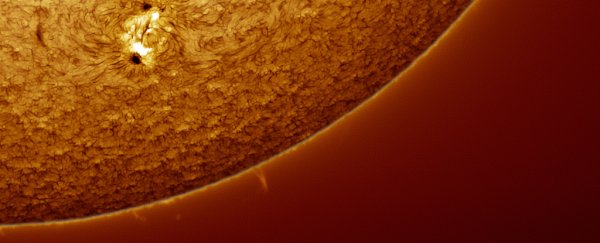The Sun is blanketed by spiking, ultra-hot jets of plasma created from electrically charged particles, and now scientists have figured out more about how these jets (or spicules) are created and driven up into the star's atmosphere.
Via a series of laboratory experiments and models, a new study co-led by astrophysicist Piyali Chatterjee from the Indian Institute of Astrophysics (IIA) describes the spicules as being like drops of paint getting bounced around on the surface of a speaker as music plays.
It's quite an unusual analogy, but the underlying physics do appear to be the same.
When a liquid is placed above a speaker that's pumping out audio, it becomes unstable and starts vibrating above a certain frequency. If that liquid is made up of what are known as long polymer chains – think paint or shampoo, for example – the liquid is fired away from the speaker in elongated jets.
 Jets of paint caused by vibrations. (Dey et al., Nature Physics, 2022)
Jets of paint caused by vibrations. (Dey et al., Nature Physics, 2022)
The same process could well be happening above the Sun, the study authors contend. It's not the throbbing beat of a bass line that's producing the spicules though, but rather the magnetic field generated by electric currents inside the Sun.
"Spurred by the visual similarity between the solar spicules and the jets of paint on the speaker, we investigated the roles of magnetic fields on the Sun using state-of-the-art numerical simulations of the solar plasma," says experimental physicist Murthy OVSN from Azim Premji University in India.
In the same way that polymer chains keep jets of paint stable above a speaker, the magnetic field around the Sun can keep the jets of plasma stable enough to shoot in a particular direction away from the star.
Technically speaking, both systems are anisotropic, where the properties of something change depending on the direction that it's traveling in – although the researchers point out that there are significant differences too, not least in scale.
"The simulations were able to reproduce a forest of jets because they explored a more realistic range of parameters than earlier studies," Chatterjee explains.
The new research challenges the existing consensus that the physics behind short solar spicules are different from the physics behind longer (and faster) solar spicules. Both could in fact be created by the same convection forces in the plasma just below the visible solar surface (the photosphere).
"The solar plasma can be imagined as threaded by magnetic field lines, much like the long chains in polymer solutions," says astrophysicist Sahel Dey, also from IIA.
Strangely, the chromosphere of the Sun (the middle of three layers of atmosphere) is hotter than the surface. Scientists think that plasma spicules might be one of the reasons why, so this discovery could help to explain more than one solar mystery.
The spicules can shoot up to 12,000 kilometers (7,456 miles) away from the Sun before being brought back down by gravity, and they can extend to widths of 1,100 kilometers (684 miles). There's a lot of variety, but these variations were accounted for in the experiments and modeling done in this study.
It's estimated that there are around 3 million spicules above the Sun at any given time, and research continues into exactly how they're generated. Getting more answers will require collaboration between scientists from several different fields.
"This novel coming together of solar astronomers and condensed matter experimentalists was able to reveal the underlying cause of the poorly understood solar spicules," says Annapurni Subramaniam, the Director of IIA, who wasn't directly involved in the study.
"The power of unifying physics that connects physically disparate phenomena will prove to be the driving force of much more interdisciplinary collaboration."
The research has been published in Nature Physics.
